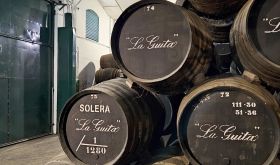From $25.99, CA$39.95, €35.50, 990 Czech koruna, £37, SG$86.97
Riesling completists, take note! Napa is probably one of the last places you might look for your fix of this most obsessive-compulsive of grapes, but Smith-Madrone prove that it can be done, and done well.
Mountain viticulture is surely one of the vital elements, and the fog-wreathed hillsides shown above give an indication of the cooling influence that will benefit Riesling. Smith-Madrone's vineyards lie between 1,300 and 2,000 feet (400–610 m) with some slopes as steep as 34% according to their website. Furthermore, their Riesling vines date from their first plantings in 1972. They are own-rooted and the vineyards unirrigated.
Such qualities indicate the sort of purist approach that bodes well, since old vines are generally revered for greater concentration of fruit and ungrafted vines are considered more authentic by some (perhaps unfairly, although they are certainly rare), while unirrigated vineyards appeal to our desire for minimal manipulation, especially when water is increasingly scarce.
(As an aside, I remember Ron Laughton of Jasper Hill telling me that all and any irrigation compromises terroir, which has logic to it, although is perhaps an example of the convenience of his own uniqueness.)
Regardless, the 2016 vintage of Smith-Madrone Riesling confirmed all the expectations of excellence. It has flavour characteristics that echo the great German archetypes, yet is distinctly New World, perhaps most obviously via soft acidity that would be unusual in most Teutonic versions. Their helpful tech sheet reveals titratable acidity on the lower side of the Riesling range, at 8.1 grams per litre, although the pH of 3.04 is typical.
Furthermore, residual sugar is 6.8 grams per litre, giving that impression of slight sweetness which is Riesling's great gift to the world. Six years of bottle age has brought out flavours of basil leaf, lime cordial, lemon meringue and a definite petrographic aroma that might be described as slate or oil or mineral, depending on your preference.
While it will doubtless continue to mature, I felt it was showing at its best for drinking right now, with intact primary fruit and maturing complexity in equal measure – it is a wine to relish in all its varietal glory.
However, many markets have moved on to the 2017 vintage, which is the current release. Our US executive editor Elaine, who knows the producer in far more detail than I do, advises that their Riesling is 'guided by style in the sense that they have to centrally pay attention to sugar levels since they want it to be on the drier side of things and so specifically aim for that style, whereas the Chardonnay and Cabernet are guided more by vintage conditions. That said, I believe their wines in general are guided by structural focus and vintage honesty.'
She adds, 'Smith-Madrone in general has worked hard to keep their wines at good value for the region and still produce one of the best-value Cabernet Sauvignons from Napa Valley as well. The consistency across their wines is excellent (with appropriate vintage variation), and they each age quite impressively as well. The two brothers who founded it got up in the mountains of the Spring Mountain District in the early 1970s, and in many ways represent the last generation that could be middle class and start a new property in Napa Valley but they also happened to get in at a time when Cabernet from mountain property was still a relatively less explored concept so land was available and restrictions were not yet in place.'
The 2017 vintage is available in the UK via Roberson Wine, while the 2016 is still available in the US and other markets.
For more of Elaine's insights into the wines of the Napa Valley, read any of her many articles on the subject. Photo © Smith-Madrone.















